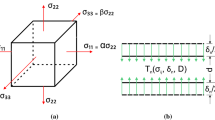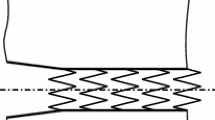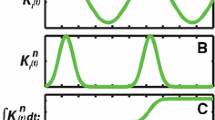Abstract
We propose a construction of fatigue laws from cohesive forces models in the case of a crack submitted to a mode I cyclic loading. Taking the cumulated opening as the memory variable and the surface energy density associated with Dugdale’s model, we explicitly construct the fatigue law which gives the crack growth rate by cycle dℓ/dN in terms of the stress intensity factor K I . In particular, we recover a Paris law with an exponent 4, i.e., dℓ/dN = C K 4 I , when K I is small, the coefficient C being explicitly expressed in terms of the material parameters. Furthermore, the law can be applied in the full range of values of K I and can be extended to non simple cycles.












Similar content being viewed by others
References
Abdelmoula R, Marigo J-J, Weller T (2009) Construction des lois de fatigue à partir de modèles de forces cohésives: cas de fissures en mode I. Comptes Rendus Mécanique 337(3):166–172
Abdelmoula R, Marigo J-J, Weller T (2009) Construction d’une loi de fatigue à partir d’un modèle de forces cohésives: cas d’une fissure en mode III. Comptes Rendus Mécanique 337(1):53–59
Abdul-Baqi A, Schreurs PJG, Geers MGD (2005) Fatigue damage modeling in solder interconnects using a cohesive zone approach. Int J Sol Struct 42:927–942
Barenblatt GI (1962) The mathematical theory of equilibrium cracks in brittle fracture. Adv Appl Mech 55–129
Bourdin B, Francfort GA, Marigo J-J (2008) The variational approach to fracture. J Elast 91(1–3):5–148
Bui HD (1978) Mécanique de la rupture fragile. Masson
Charlotte M, Laverne J, Marigo J-J (2006) Initiation of cracks with cohesive force models: a variational approach. Eur J Mech A-Solid 25(4):649–669
Cherepanov GP (1979) Mechanics of brittle fracture. McGraw-Hill International Book Company, London
Dal Maso G, Francfort GA, Toader R (2005) Quasistatic crack growth in nonlinear elasticity. Arch Ration Mech Anal 176(2):165–225
Dal Maso G, Toader R (2002) A model for the quasi-static growth of brittle fractures: existence and approximation results. Arch Ration Mech Anal 162:101–135
Dugdale DS (1960) Yielding of steel sheets containing slits. J Mech Phys Solids 8:100–108
Ferdjani H, Abdelmoula R, Marigo J-J (2007) Insensitivity to small defects of the rupture of materials governed by the Dugdale model. Continuum Mech Therm 19(3-4):191–210
Ferriero A (2008) Quasi-static evolution for fatigue debonding. ESAIM Control Optim Calc Var 4(2):233–253
Francfort GA, Marigo J-J (1998) Revisiting brittle fracture as an energy minimization problem. J Mech Phys Solids 46(8):1319–1342
Francfort GA, Mielke A (2006) Existence results for a class of rate-independent material models with nonconvex elastic energies. J Reine Angew Math 595:55–91
Giacomini A (2005) Size effects on quasi-static growth of cracks. SIAM J Math Anal 36(6):1887–1928 (electronic)
Griffith A (1920) The phenomena of rupture and flow in solids. Phil Trans Roy Soc Lond CCXXI(A):163–198
Jaubert A, Marigo J-J (2005) L’approche variationnelle de la fatigue : des premiers résultats. Comptes Rendus Mécanique 333(7):550–556
Jaubert A, Marigo J-J (2006) Justification of Paris-type fatigue laws from cohesive forces model via a variational approach. Continuum Mech Therm V18(1):23–45
Laverne J, Marigo J-J (2004) Global approach, relative minima and yield criterion in fracture mechanics. Comptes Rendus Mécanique 332(4):313–318
Lawn B (1993) Fracture of brittle solids. Cambridge solid state science series, 2nd edn. Cambridge University press, Cambridge
Maiti S, Geubelle P (2005) A cohesive model for fatigue failure of polymers. Eng Fract Mech 72(5):691–708
Marigo J-J (1985) Modelling of brittle and fatigue damage for elastic material by growth of microvoids. Eng Fract Mech 21(4):861–874
Marigo J-J, Truskinovky L (2004) Initiation and propagation of fracture in the models of Griffith and Barenblatt. Continuum Mech Therm 16(4):391–409
Mielke A (2005) Evolution of rate-independent systems. In: Evolutionary equations, volume II of Handb Differ Equ. Elsevier/North-Holland, Amsterdam, pp 461–559
Muskhelishvili NI (1953) Some basic problems of mathematical theory of elasticity, 2nd edn. P. Noordhoff Ltd, Groningen
Needleman A (1992) Micromechanical modelling of interface decohesion. Ultramicroscopy 40:203–214
Nguyen O, Repetto EA, Ortiz M, Radovitzki RA (2001) A cohesive model of fatigue crack growth. Int J Fract 110:351–369
Nguyen QS (2000) Stability and nonlinear solid mechanics. Wiley, London
Paris PC, Erdogan F (1963) A critical analysis of crack propagation laws. J Basic Eng 85:528–534
Paris PC, Gomez MP, Anderson WE (1961) A rational analytic theory of fatigue. Trend Eng 13(8):9–14
Roe KL, Siegmund T (2002) An irreversible cohesive zone model for interface fatigue crack growth simulation. Eng Fract Mech 70:209–232
Siegmund T (2004) A numerical study of transient fatigue crack growth by use of an irreversible cohesive zone model. Int J Fatigue 26(9):929–939
Suresh S (1998) Fatigue of materials. Cambridge Editions, Cambridge
Weertman J (1966) Rate of growth of fatigue cracks calculated from the theory of infinitesimal dislocations distributed on a plane. Int J Frac Mech 2:460–467
Yang B, Mall S, Ravi-Chandar K (1999) A cohesive zone model for fatigue crack growth in quasibrittle materials. Int J Sol Struct 38:3927–3944
Author information
Authors and Affiliations
Corresponding author
Appendix 1: The generic problem in the neighborhood of the crack tip
Appendix 1: The generic problem in the neighborhood of the crack tip
The plane is equipped with the cartesian coordinate system (x, y), the associated canonical basis is (i, j) and \(z=x+{\tt i} y\) denotes the affixe of the complex number associated with the point (x, y). Let \({\tt K}\), \({\tt L}\) and \({\tt D}\) be three given real numbers with \({\tt K}>0\) and \({\tt D}>0\). Let us consider the following plane-strain elastic problem whose unknowns are the displacement and stress field U and \(\varvec{\Upsigma}\):
with the condition at infinity
where \(x=r\cos\theta, y=r\sin\theta\) and \({\bf u}^S(\theta)=(3-4\nu-\cos\theta)\left(\cos \frac{\theta}{2} {\bf i}+ \sin \frac{\theta}{2} {\bf j}\right)\). This problem admits a unique solution which can be obtained in a closed form by using the theory of complex potentials, cf [26]. We simply recall here the main results. The fields U et \(\varvec{\Upsigma}\) are related to the function φ(z) of the complex variable z by
φ being holomorphic in the plane without the half-line \((-\infty,\,{\tt L}+{\tt D})\times\{0\}\), the bar denoting the complex conjugate. By a standard procedure, we get
Near the tip \(z={\tt L}+{\tt D}, \varphi^\prime(z)\) behaves like
and hence the stresses are singular with the usual singularity in \(1/\sqrt{r}\) except if the factor \(\sqrt{2\pi}{\tt K}-4\sigma_c\sqrt{{\tt D}}\) vanishes. Specifically, the jump of the normal displacement just behind the tip \(x={\tt L}+{\tt D}\) and the normal stress just ahead the tip read as
Therefore, if it is required that \(\Upsigma_{22}\le\sigma_c\) on the half-line \(({\tt L}+{\tt D},+\infty) \times \{0\},\) then \({\tt K}\) and \({\tt D}\) must be such that \(\sqrt{2\pi}{\tt K}\le4\sigma_c\sqrt{{\tt D}}\). On the other hand, if it is required that \(\lbrack\!\lbrack U_2 \rbrack\!\rbrack \ge 0\) holds everywhere (by a non interpenetration condition, for instance), then \({\tt K}\) and \({\tt D}\) must satisfy the converse inequality \(\sqrt{2\pi}{\tt K}\ge4\sigma_c\sqrt{{\tt D}}\). Accordingly, in order that both conditions are satisfied, the solution must be non singular at the tip \({\tt L}+{\tt D}\). In such a case \({\tt D}\) and \({\tt K}\) are related by
Assuming from now on that (52) holds, (51) becomes
In (53), Log denotes the principal determination of the complex logarithm. After some calculations, one obtains that the normal jump of the displacement along the x-axis reads as
where V denotes the dimensionless real-valued function defined by
and V(0) = 1. Let us note that V is continuously differentiable everywhere (even at ζ = 0 and ζ = 1), is concave for ζ ≤ 0 and is strictly decreasing from ∞ to 0 when ζ goes from −∞ to 1. When ζ→ −∞, \(V(\zeta)=2\sqrt{|\zeta|}+o(1)\). The non interpenetration condition \(\lbrack\!\lbrack U_2 \rbrack\!\rbrack \ge 0\) is satisfied everywhere. The normal stress \(\Upsigma_{22}\) along the half-line \(({\tt L}+{\tt D},+\infty) \times \{0\}\) is given by
It decreases from σ c to 0 and, therefore, the condition \(\Upsigma_{22}\le\sigma_c\) is satisfied.
Rights and permissions
About this article
Cite this article
Abdelmoula, R., Marigo, JJ. & Weller, T. Construction and justification of Paris-like fatigue laws from Dugdale-type cohesive models. Ann. Solid Struct. Mech. 1, 139–158 (2010). https://doi.org/10.1007/s12356-010-0011-3
Received:
Accepted:
Published:
Issue Date:
DOI: https://doi.org/10.1007/s12356-010-0011-3




